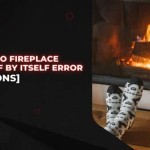Floating Fireplace Mantel Brackets: A Comprehensive Guide
The floating fireplace mantel has become a popular design choice, offering a minimalist and modern aesthetic that complements various interior styles. Achieving the illusion of a mantel suspended in mid-air requires careful planning and the use of specialized mounting hardware, specifically floating fireplace mantel brackets. These brackets provide the necessary support and stability to safely and securely hold the mantel in place while maintaining the desired floating appearance. This article provides a comprehensive overview of floating fireplace mantel brackets, covering their types, selection criteria, installation considerations, and safety aspects.
Understanding Floating Fireplace Mantel Brackets
Floating fireplace mantel brackets are structural components designed to be concealed within the mantel itself and the surrounding wall. They are typically constructed from heavy-duty steel or other robust materials to withstand the weight of the mantel and any decorative items placed upon it. The brackets are engineered to distribute the load evenly, preventing sagging or failure of the mantel over time. The core principle behind their design is to provide a secure anchor point within the wall studs or masonry, allowing the mantel to extend outwards without visible support.
These brackets consist of two primary components: the mounting plate and the support rod. The mounting plate is attached to the wall, typically anchored to studs or masonry using appropriate fasteners. The support rod is welded to the mounting plate and extends outwards, fitting into a pre-drilled hole or channel within the mantel itself. The precise dimensions and configuration of these components vary depending on the size, weight, and material of the mantel.
The effectiveness of floating fireplace mantel brackets hinges on several factors, including the quality of the materials used, the precision of the manufacturing process, and the correct installation technique. A failure to properly select or install these brackets can result in a compromised installation, posing a safety hazard. Therefore, a thorough understanding of the available options and best practices is essential.
Types of Floating Fireplace Mantel Brackets
The market offers a variety of floating fireplace mantel brackets, each designed to accommodate different mantel weights, sizes, and installation requirements. Common types include:
Hidden Steel Brackets: These are the most common type, consisting of a flat steel plate that attaches to the wall and a series of steel rods or tubes that extend into the mantel. They offer a clean, minimalist look and are suitable for a wide range of mantel sizes and weights. They are typically hidden entirely within the mantel, providing a seamless appearance.
Heavy-Duty Steel Brackets: Designed for heavier mantels or those with significant depth, these brackets feature thicker steel and reinforced welds for increased load-bearing capacity. They often include multiple support rods or a more robust mounting plate to ensure stability. These are crucial for mantels made of dense materials such as stone or thick solid wood.
Adjustable Floating Mantel Brackets: These brackets offer a degree of adjustability, allowing for fine-tuning of the mantel's position after installation. This is particularly useful for installations where the wall is not perfectly level or where a slight adjustment is desired for aesthetic purposes. The adjustability feature usually involves threaded components that can be tightened or loosened to alter the height or angle of the mantel.
Blind Shelf Supports: While primarily designed for shelves, these brackets can also be adapted for use with fireplace mantels, particularly smaller or lighter ones. They typically feature a single, thick rod that inserts into the mantel. Their weight capacity is generally lower than dedicated mantel brackets, so careful consideration is required.
The choice of bracket type depends heavily on the specifics of the installation. Factors such as the mantel's weight, dimensions, material, and desired projection from the wall all play a role in determining the appropriate bracket selection.
Selecting the Right Floating Fireplace Mantel Brackets
Choosing the appropriate floating fireplace mantel brackets is a critical step in ensuring a safe and aesthetically pleasing installation. Several key factors should be considered during the selection process:
Weight Capacity: The most important factor is the weight capacity of the brackets. The combined weight of the mantel and any decorative items placed upon it must not exceed the bracket's rated load. It is advisable to select brackets with a safety margin, exceeding the anticipated weight by a significant percentage. This helps ensure long-term stability and prevents potential failure under unexpected loads.
Mantel Dimensions: The size and shape of the mantel will influence the required bracket dimensions and placement. Longer or deeper mantels require brackets with longer support rods and potentially more of them to distribute the load evenly. The bracket's mounting plate should also be sized appropriately to ensure a secure connection to the wall studs or masonry.
Wall Construction: The type of wall construction (e.g., drywall, brick, concrete) will dictate the type of fasteners required and the method of attachment. Drywall installations require locating and anchoring to wall studs, while brick or concrete installations require specialized anchors designed for these materials. The chosen brackets should be compatible with the wall construction and allow for secure attachment using appropriate fasteners.
Material and Finish: The material and finish of the brackets should be durable and resistant to corrosion. Steel brackets are typically powder-coated or painted to protect against rust. The finish should also be compatible with the overall aesthetic of the fireplace and surrounding decor. A high-quality finish will ensure the brackets remain visually appealing and functional for years to come.
Installation Complexity: Consider the level of difficulty involved in installing the chosen brackets. Some brackets are easier to install than others, particularly for DIY projects. If the installation is complex or requires specialized tools, it may be advisable to hire a professional installer. Detailed instructions and readily available support from the bracket manufacturer are also beneficial.
When selecting floating fireplace mantel brackets, it is essential to prioritize safety and structural integrity. Cheap or poorly designed brackets can compromise the entire installation and pose a significant safety risk. Investing in high-quality brackets from a reputable manufacturer is a worthwhile investment.
Installation Considerations for Floating Fireplace Mantel Brackets
Proper installation of floating fireplace mantel brackets is crucial for ensuring the stability and safety of the mantel. The following considerations should be taken into account:
Accurate Measurement and Marking: Precise measurements and markings are essential for ensuring that the brackets are properly aligned and level. Use a level, measuring tape, and stud finder to accurately locate and mark the positions of the wall studs and bracket mounting locations. Any errors in measurement or marking can result in a skewed or unstable installation.
Stud Location and Attachment: For drywall installations, the brackets must be securely anchored to wall studs. Use a stud finder to accurately locate the studs and mark their positions. Pre-drill pilot holes before inserting screws to prevent splitting the wood. Use screws of the appropriate length and thickness to ensure a strong connection. If studs are not ideally positioned, consider using a ledger board securely attached to multiple studs to provide a solid mounting surface for the brackets.
Masonry Attachment: For brick or concrete installations, use specialized masonry anchors designed for the specific type of material. Drill pilot holes according to the anchor manufacturer's instructions and insert the anchors securely. Ensure that the anchors are rated for the weight of the mantel and brackets. The use of hammer drills and appropriate drill bits is critical for effective masonry installation.
Mantel Preparation: The mantel itself must be properly prepared to receive the support rods of the brackets. Drill holes or create channels within the mantel to accommodate the rods. The holes should be slightly larger than the rods to allow for easy insertion and removal. Ensure that the holes are drilled accurately and at the correct depth to ensure proper alignment and stability.
Leveling and Alignment: After installing the brackets and inserting the mantel, use a level to ensure that the mantel is perfectly level. If necessary, use shims to make minor adjustments. Check the alignment of the mantel with the fireplace and surrounding walls to ensure a visually appealing installation.
Securing the Mantel: Depending on the design of the brackets and the mantel, it may be necessary to further secure the mantel to the brackets. This can be achieved using screws, adhesive, or other fasteners. The method of attachment will depend on the specific materials and the desired level of security. Ensure that the chosen method does not compromise the aesthetic of the floating mantel.
Adhering to these installation considerations will contribute to a safe, stable, and visually pleasing floating fireplace mantel installation. If unsure about any aspect of the installation process, seeking professional assistance is recommended.
Safety Aspects of Floating Fireplace Mantel Brackets
Safety should be the paramount concern when installing a floating fireplace mantel. Several safety aspects should be carefully considered throughout the entire process:
Load Capacity Compliance: Always adhere to the manufacturer's specified load capacity for the chosen brackets. Exceeding the load capacity can result in bracket failure, leading to a potential collapse of the mantel and posing a significant safety hazard. Regularly inspect the mantel and brackets for any signs of stress or damage, such as sagging, cracking, or loose fasteners.
Fire Safety: Ensure that the mantel and brackets are installed at a safe distance from the fireplace opening to prevent overheating or combustion. Refer to local building codes and manufacturer guidelines for minimum clearance requirements. Use fire-resistant materials for the mantel and consider installing a heat shield to protect the mantel from excessive heat.
Secure Fastening: Use high-quality fasteners that are appropriate for the wall construction and the weight of the mantel. Ensure that the fasteners are properly tightened and that they are not prone to loosening over time. Regularly inspect the fasteners and tighten them as needed. Consider using locking washers or other methods to prevent loosening due to vibration or movement.
Professional Installation: If unsure about any aspect of the installation process, seek the assistance of a qualified professional. A professional installer will have the expertise and experience to ensure that the brackets are properly installed and that the mantel is safe and stable. They can also advise on the appropriate bracket selection and installation techniques based on the specific circumstances.
Regular Inspection and Maintenance: Periodically inspect the mantel and brackets for any signs of damage or wear. Check for sagging, cracking, loose fasteners, or other potential problems. Address any issues promptly to prevent further damage or potential safety hazards. Regular maintenance can help prolong the life of the mantel and brackets and ensure continued safety.
By carefully considering these safety aspects, one can minimize the risk of accidents and ensure a safe and enjoyable fireplace experience. Prioritizing safety throughout the entire process is essential for protecting oneself and others from potential harm.

Stylish And Simple Mantel Brackets For Easy Diy Projects

Rustic Mantel Support Sold Individually Fireplace Bracket With Lip Heavy Duty Brackets Wood Mantle Shelf Supports Israel

Farmhouse Mantel Brackets Fireplace Bracket Metal Supports Rustic Shelving

Rustic Fireplace Mantel With Metal Brackets 5x6 6x6 6x8 Or Old West Iron

Mantel Shelf Bracket Sold Individually Fireplace Decor Rustic Farmhouse Industrial

Glenn Heavy Duty Diy Floating Mantel Bracket Shelfology

Rustic Mantel Bracket Sold Individually Industrial Black Heavy Duty Metal Wall Mount Mantle

How To Install A Floating Mantle The Easy Way In Just One Afternoon

Corbel For Mantle High Quality Artisan Made In The Usa Metal Decor Fireplace Brackets Mantel Bracket Custom

The Irresistible Allure Of Floating Mantel Shelves
Related Posts








